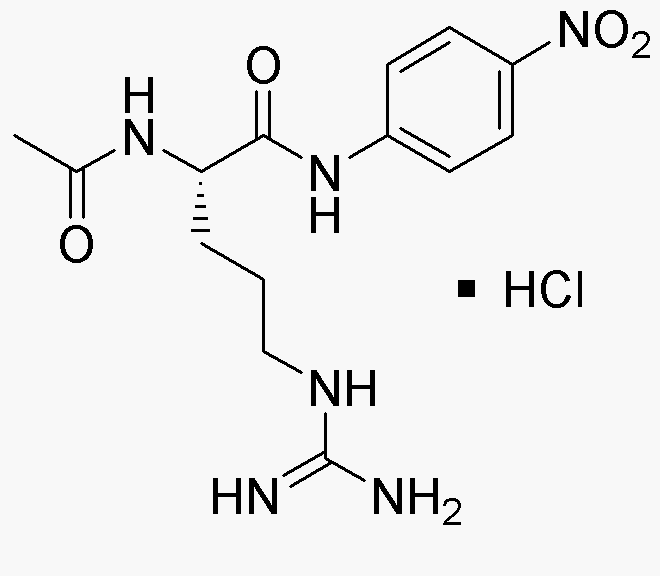Na-Acetyl-L-arginine 4-nitroanilide hydrochloride is widely utilized in research focused on:
- Biochemical Assays: This compound serves as a substrate in enzyme assays, particularly for studying arginase activity, which is crucial in various metabolic pathways.
- Drug Development: It plays a role in the development of nitric oxide donors, which can be significant in cardiovascular research and therapies.
- Protein Interaction Studies: Researchers use it to investigate protein-ligand interactions, aiding in the understanding of cellular signaling mechanisms.
- Diagnostics: The compound can be employed in diagnostic tests for certain diseases, providing insights into metabolic disorders related to arginine metabolism.
- Pharmaceutical Formulations: It is included in formulations aimed at enhancing drug delivery systems, improving the bioavailability of therapeutic agents.
General Information
Properties
Safety and Regulations
Applications
Na-Acetyl-L-arginine 4-nitroanilide hydrochloride is widely utilized in research focused on:
- Biochemical Assays: This compound serves as a substrate in enzyme assays, particularly for studying arginase activity, which is crucial in various metabolic pathways.
- Drug Development: It plays a role in the development of nitric oxide donors, which can be significant in cardiovascular research and therapies.
- Protein Interaction Studies: Researchers use it to investigate protein-ligand interactions, aiding in the understanding of cellular signaling mechanisms.
- Diagnostics: The compound can be employed in diagnostic tests for certain diseases, providing insights into metabolic disorders related to arginine metabolism.
- Pharmaceutical Formulations: It is included in formulations aimed at enhancing drug delivery systems, improving the bioavailability of therapeutic agents.
Documents
Safety Data Sheets (SDS)
The SDS provides comprehensive safety information on handling, storage, and disposal of the product.
Product Specification (PS)
The PS provides a comprehensive breakdown of the product’s properties, including chemical composition, physical state, purity, and storage requirements. It also details acceptable quality ranges and the product's intended applications.
Certificates of Analysis (COA)
Search for Certificates of Analysis (COA) by entering the products Lot Number. Lot and Batch Numbers can be found on a product’s label following the words ‘Lot’ or ‘Batch’.
*Catalog Number
*Lot Number
Certificates Of Origin (COO)
This COO confirms the country where the product was manufactured, and also details the materials and components used in it and whether it is derived from natural, synthetic, or other specific sources. This certificate may be required for customs, trade, and regulatory compliance.
*Catalog Number
*Lot Number
Safety Data Sheets (SDS)
The SDS provides comprehensive safety information on handling, storage, and disposal of the product.
DownloadProduct Specification (PS)
The PS provides a comprehensive breakdown of the product’s properties, including chemical composition, physical state, purity, and storage requirements. It also details acceptable quality ranges and the product's intended applications.
DownloadCertificates of Analysis (COA)
Search for Certificates of Analysis (COA) by entering the products Lot Number. Lot and Batch Numbers can be found on a product’s label following the words ‘Lot’ or ‘Batch’.
*Catalog Number
*Lot Number
Certificates Of Origin (COO)
This COO confirms the country where the product was manufactured, and also details the materials and components used in it and whether it is derived from natural, synthetic, or other specific sources. This certificate may be required for customs, trade, and regulatory compliance.


